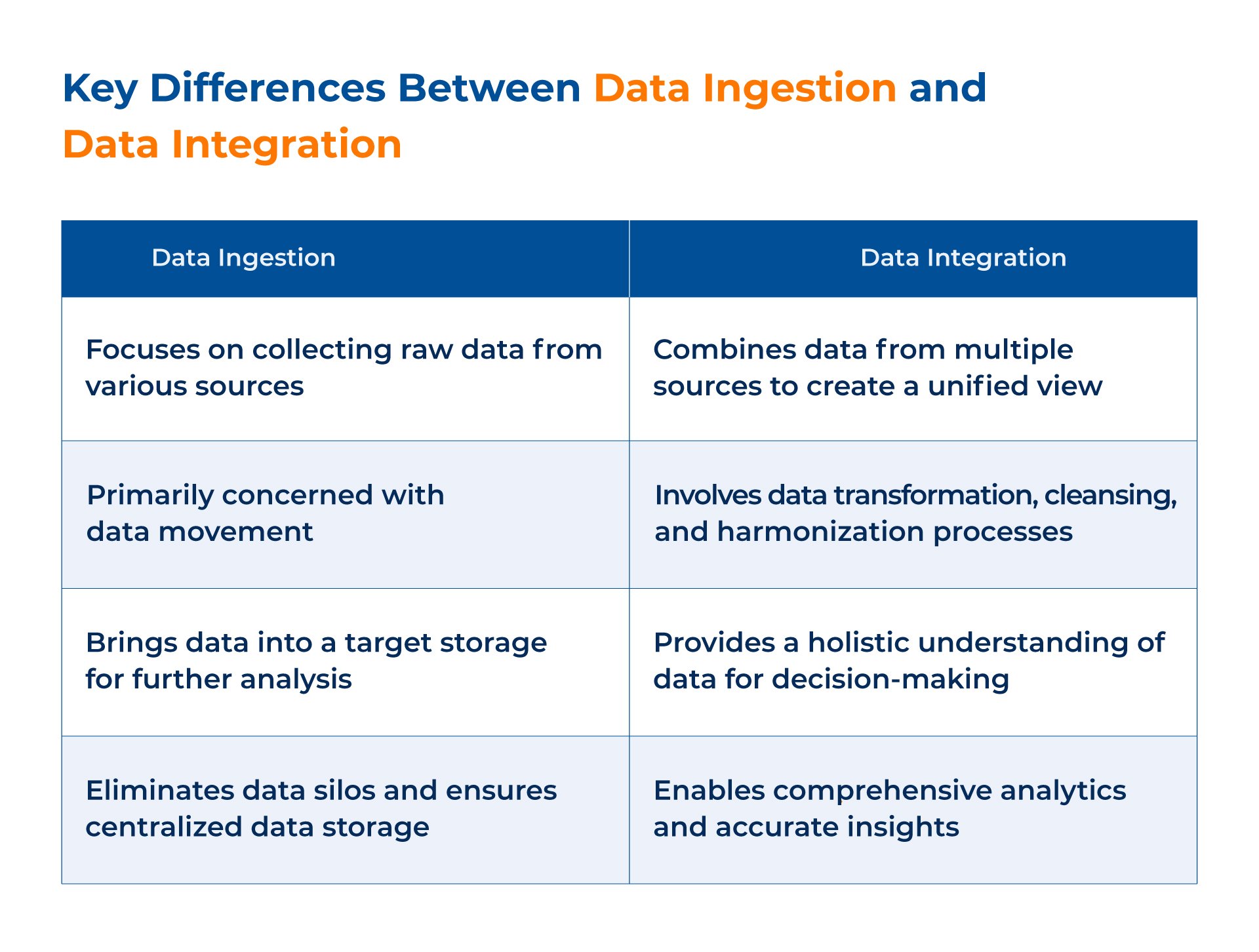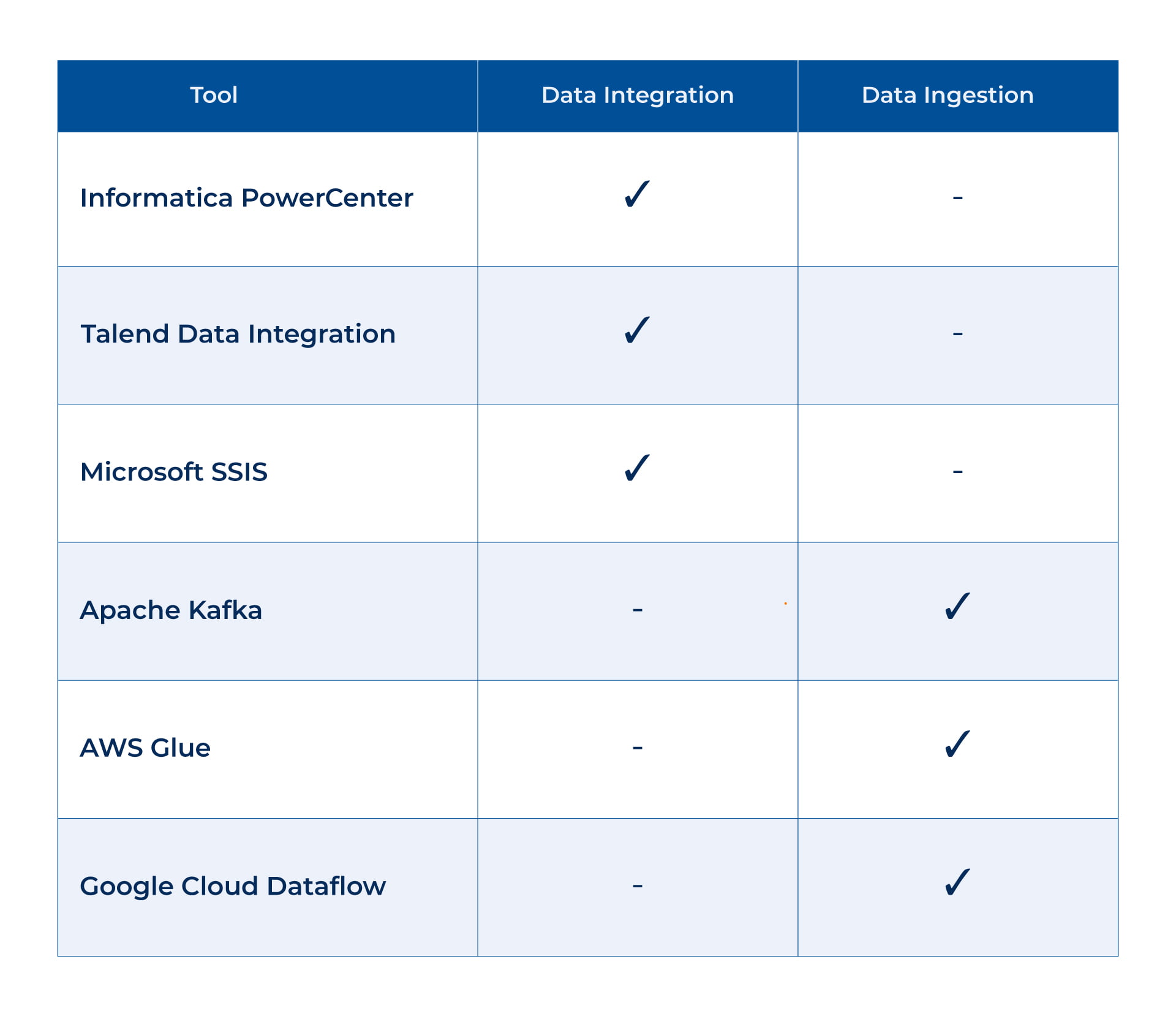Two key processes come into play when managing data: data ingestion and integration. While both processes are essential for effective data management, their approach and objectives differ. Understanding data ingestion vs. data integration is crucial for making informed decisions about your data management strategy.
Data ingestion involves collecting raw data from various sources and loading it into a target storage. This process aims to bring all your data from different sources into a single location, eliminating data silos and providing a holistic view of your data. It includes extracting, transforming, and loading (ETL Process) data into a target system, such as a data warehouse or data lake. On the other hand, data integration focuses on combining data from multiple sources to create a unified view.

What is Data Ingestion?
Data ingestion is a fundamental process in data management that involves extracting raw data from various sources and loading it into a database, data warehouse, or data lake. This raw data, also known as the source data, can come from databases, APIs, log files, sensors, social media, or IoT devices. The primary objective of data ingestion is to bring all this diverse and scattered data into a single location, eliminating data silos and enabling organizations to have a holistic view of their data.
Data ingestion can be done manually, where data is manually extracted and loaded, or it can be automated using data ingestion tools. Automated data ingestion simplifies the process by automatically collecting and transforming the data, making it more efficient and reliable. This process is often referred to as a data pipeline, where data flows from the source to the target storage, ensuring a continuous and seamless flow of data.

Key Features of Data Ingestion
Data ingestion offers several key features that make it an essential component of data management strategies. These features enable organizations to handle large volumes of data effectively, support different data types, and ensure data security and privacy.
1. Scalability
One of the key features of data ingestion is its scalability. As organizations accumulate more data, it is crucial to have a data ingestion process that can handle increasing volumes without sacrificing performance. Scalability allows organizations to expand their data storage and processing capabilities as their needs grow, ensuring a smooth and efficient data ingestion workflow.
2. Data Variety
Data ingestion supports various types of data, including structured, semi-structured, and unstructured data. This feature enables organizations to collect data from diverse sources, such as databases, APIs, logs, and social media platforms. By ingesting data of different formats and structures, organizations can gain insights from a wide range of sources and have a comprehensive view of their data.
3. Data Security
Data security and privacy are essential aspects of data management. Ingestion incorporates security measures, such as encryption and protocols like Secure Sockets Layer (SSL) and HTTP over SSL, to ensure the confidentiality and integrity of the ingested data. These measures protect sensitive information from unauthorized access and maintain data privacy compliance.

What is Data Integration?
Data integration is a crucial process that involves combining data from different sources to create a unified view of the data. It goes beyond the simple act of data ingestion and includes extracting data from various sources, transforming it into a consistent format, and loading it into a target system such as a data warehouse or data lake. This unified view gives organizations a holistic understanding of their data, facilitating better decision-making and analysis.
Why is Data Integration important?
Data integration is pivotal in enabling organizations to gain valuable insights from their data. By combining data from disparate sources, businesses can break down data silos and create a comprehensive view of their operations, customers, and market trends. This unified view allows for a more accurate analysis of data, leading to informed business strategies, improved efficiency, and better customer experiences.
In addition, data integration helps organizations overcome challenges related to data quality and consistency. By transforming and standardizing data from different sources, organizations can ensure data accuracy and reliability, enhancing the overall quality of their analytics. Furthermore, data integration supports data governance efforts, providing a structured approach to data management and ensuring compliance with regulatory requirements.

Benefits of Data Integration
Data integration offers several key benefits to organizations:
1. Improved decision-making:
By providing a unified view of data, data integration enables organizations to make informed decisions based on accurate and comprehensive insights.
2. Enhanced data quality:
Data integration processes include data cleansing and transformation, resulting in improved data quality and consistency.
3. Streamlined operations:
With a unified view of data, organizations can streamline their operations by eliminating redundant processes and optimizing resource allocation.
Case Study- Streamlining Data Flow with Advanced Integration
4. Better customer experiences:
Data integration allows organizations to gain a deeper understanding of their customers by consolidating data from various touchpoints, enabling personalized and targeted experiences.
5. Increased efficiency:
By automating data integration processes, organizations can save time and resources, freeing up valuable personnel for other tasks.
Data integration plays a vital role in enabling organizations to leverage the full potential of their data. By combining data from multiple sources and creating a unified view, businesses can make more informed decisions, improve operational efficiency, and enhance customer experiences. With the right data integration strategy and tools in place, organizations can unlock the true value of their data and gain a competitive edge in the market.

Key Features of Data Integration
Data integration offers several key features that are essential for efficient and effective data management. These features contribute to the smooth integration of data from various sources, ensuring data transformation, quality, and security.
1. Data Transformation
Data transformation is a crucial feature of data integration that facilitates the standardization and cleaning of data from different sources. By transforming data into a consistent format, organizations can eliminate inconsistencies and achieve data uniformity, making it more usable for analysis and decision-making.
2. Data Quality
Data quality is another important aspect of data integration. It involves implementing checks and validation processes at each stage of the integration process to ensure that the data is accurate, complete, and reliable. By maintaining high-quality data, organizations can make informed decisions and avoid costly errors that may arise from using inaccurate or incomplete data.
3. Data Governance and Security
Data governance and security are paramount in data integration. Organizations must establish policies and protocols to govern the access, storage, and usage of data. This ensures that data is protected from unauthorized access and maintains compliance with privacy regulations. By implementing robust data security measures, organizations can safeguard sensitive information and build trust with their stakeholders.
Data integration also enables flexibility and scalability, allowing organizations to handle large volumes of data efficiently without compromising performance. Through the seamless integration of data from various sources, organizations can unlock valuable insights, drive business growth, and gain a competitive edge in today’s data-driven world.

Data Ingestion vs. Data Integration: Key Differences
Data ingestion and data integration are two essential processes in data management strategies. While they both involve handling data from multiple sources, they have distinct objectives and approaches. Understanding the key differences between data ingestion and data integration is crucial for organizations to make informed decisions and effectively manage their data.
Data Ingestion:
Data ingestion focuses on efficiently collecting raw data from various sources and loading it into a target storage, such as a database, data warehouse, or data lake. The primary goal is to bring data from different sources into a centralized location, eliminating data silos and enabling a holistic view of the data. Data ingestion can be performed manually or automated using specialized data ingestion tools.
Data Integration:
On the other hand, data integration involves combining data from different sources to create a unified view of the data. It includes extracting data from multiple sources, transforming it into a consistent format, and loading it into a target system, typically a data warehouse or data lake. The objective of data integration is to harmonize data from various sources, ensuring data accuracy and enabling better decision-making and analysis.
Table: Key Differences Between Data Ingestion and Data Integration

Challenges of Data Ingestion and Data Integration
Both data ingestion and data integration processes come with their fair share of challenges.
Let’s explore some of the common hurdles faced in these areas:
1. Limited Data Quality Control in Data Ingestion
Data ingestion involves collecting raw data from various sources, which can sometimes lead to issues with data quality. As the volume of data increases, ensuring the accuracy and consistency of the ingested data becomes crucial. Inaccurate or incomplete data can hinder decision-making and analysis. Therefore, organizations must implement robust data quality control measures to validate and cleanse the ingested data.
2. Data Compatibility and System Integration Challenges in Data Integration
Data integration is a complex process that requires harmonizing data from different sources into a unified view. One significant challenge is ensuring compatibility between various systems and data formats. Integrating data from disparate sources may involve incompatible schemas, data structures, and system constraints. It requires careful mapping and transformation of data to ensure seamless integration and avoid inconsistencies.
3. Scalability and Performance Issues
Both data ingestion and data integration can face scalability and performance challenges. As the volume of data grows, the processes need to handle large datasets efficiently without compromising performance. Ensuring that the infrastructure, hardware, and software scale is crucial. Organizations need to invest in scalable solutions and optimize the performance of their data ingestion and integration pipelines.

Benefits of Automation in Data Management
Automation plays a crucial role in data management, offering numerous benefits for organizations seeking to streamline their processes and improve efficiency. Whether it’s data ingestion, data integration, or overall data management, automation can provide significant advantages for your business.
1. Time and Resource Savings
One of the key benefits of automation in data management is the ability to save time and resources. By automating data ingestion and integration processes, organizations can eliminate manual data entry and repetitive tasks. This allows professionals to focus on higher-value activities that require their expertise, ultimately increasing productivity and freeing up valuable time and resources.
2. Enhanced Accuracy and Data Quality
Automation also improves data accuracy and quality. Manual data entry is prone to human errors, such as typos or data inconsistencies. By automating data management processes, organizations can ensure data consistency and eliminate common mistakes, resulting in more accurate insights and analysis. Automation can also include data validation and cleansing processes, further enhancing the overall quality of the data.
3. Improved Data Security
Data security is a top priority for any organization, and automation can help enhance data protection. With automated data management, organizations can implement robust security measures, such as encryption and secure data transfer protocols, to safeguard sensitive information. Automation also reduces the risk of unauthorized access or data breaches, ensuring that data remains secure throughout the entire data management process.

Data Integration and Data Ingestion Tools
When it comes to data integration and data ingestion, organizations have a range of tools at their disposal. These tools are designed to facilitate the process of combining data from various sources and loading it into a target storage. By choosing the right tool, organizations can streamline their data management processes and improve their overall efficiency.
Popular Data Integration Tools
Data integration tools are instrumental in harmonizing data from multiple sources and providing a unified view. Some popular data integration tools include:
- Informatica PowerCenter: A comprehensive data integration platform that offers end-to-end functionality for data integration.
- Talend Data Integration: An open-source tool that allows users to connect, access, and transform data from various sources.
- Microsoft SQL Server Integration Services (SSIS): A powerful ETL (Extract, Transform, Load) tool for data integration within the Microsoft SQL Server environment.
Effective Data Ingestion Tools
Data ingestion tools are vital in collecting raw data from different sources and loading it into target storage for further analysis. Some effective data ingestion tools include:
Choosing the right data integration and data ingestion tools depends on various factors; such as the organization’s technical expertise, budget, and specific business needs. It is essential to evaluate the features, scalability, and compatibility of these tools to ensure they align with your data management requirements.

Making the Right Choice for Your Business
When it comes to managing your data, choosing between data ingestion and data integration can have a significant impact on your business. Understanding your specific needs and goals is crucial in making the right decision. Data ingestion is ideal for quickly transferring data from multiple sources to a central repository. It allows you to collect raw data and load it into target storage, eliminating data silos and providing a holistic view of your data.
On the other hand, data integration focuses on combining data from different sources to create a unified view. It involves data transformation, cleansing, and harmonization processes to ensure data consistency and accuracy. With data integration, you can have a single source of truth, enabling better decision-making and analysis.
When considering whether to choose data ingestion or data integration, it’s important to assess your business needs. If you require immediate access to raw data from various sources, data ingestion may be the right choice. However, if you need a comprehensive and unified view of your data, data integration is the way to go.
To determine which approach suits your business best, ask yourself the following questions:
- What are your data requirements? Consider the volume, variety, and types of data you need to work with.
- Do you need real-time access to raw data? Data ingestion allows you to collect and load data quickly, while data integration might involve additional processing time.
- How scalable does your data solution need to be? Consider the growth of your data and whether your chosen approach can handle increasing volumes efficiently.
- What resources and expertise are available in your organization? Data integration may require more technical knowledge and resources than data ingestion.
By evaluating your business needs and goals, you can make an informed decision on whether to prioritize data ingestion or data integration. Remember, automation tools can also play a significant role in streamlining these processes, improving efficiency, and ensuring data accuracy and security.

FAQs
1. What is data ingestion?
Data ingestion is the process of extracting raw data from various sources and loading it into a database, data warehouse, or data lake for further analysis or processing.
2. What are the key features of data ingestion?
The key features of data ingestion include scalability, support for different types of data, data security and privacy, and centralized data storage.
3. What is data integration?
Data integration involves combining data from different sources to create a unified view of the data in a target system such as a data warehouse or data lake.
4. What are the key features of data integration?
The key features of data integration include data transformation, data quality checks, data governance and security, and flexibility and scalability.
5. What are the main differences between data ingestion and data integration?
Data ingestion focuses on bringing data from various sources into target storage, while data integration aims to combine data from different sources to provide a unified view. Data ingestion is simpler and concerned with data movement, while data integration involves data transformation and cleansing processes.
6. What challenges do data ingestion and data integration face?
Data ingestion may encounter issues with data quality, latency, and scalability, while data integration faces challenges related to data quality, governance, and system compatibility.
7. What are the benefits of automation in data management?
Automation can save time and resources, eliminate manual data entry, reduce the risk of errors, streamline workflows, ensure data security and accuracy, and allow professionals to focus on higher-value tasks.
8. What tools are available for data integration and data ingestion?
Organizations have various options for data integration and data ingestion tools, including programmable web interfaces, visual web designers, IDEs, and programming frameworks.
9. How do I make the right choice for my business?
Choosing between data ingestion and data integration depends on your specific business needs and goals. Assess your data requirements, scalability needs, and available resources to determine the right approach.
